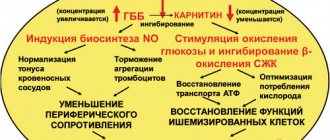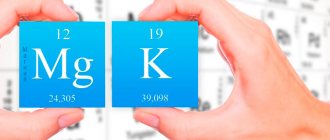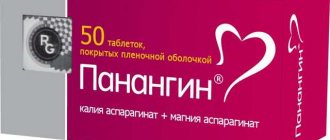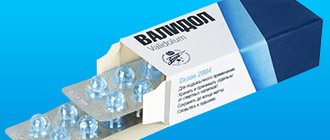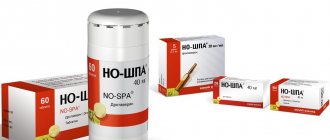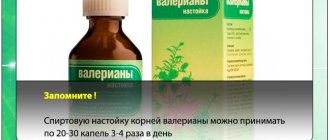Good afternoon, my readers!
Today we will talk about two healthy drugs, their differences and similarities and find out whether they can be taken together and which is better? As you may have guessed from the title, we will talk about Panangin and Riboxin, at the beginning I decided to describe the complete instructions for Riboxin, first for intravenous administration, and then for tablets, in order to close this issue for you and make this article almost independent, so that you can read it opened it and immediately found the information you were interested in. The full instructions for the second drug can be read here. After the instructions, I will describe the effect of both of these drugs on the body as a whole, and you and I will draw conclusions from all of this. Also, there will be a few words about reviews. Links to sources, as always, are below the article. Enjoy reading!
Panangin and Riboxin are medications used in cardiological practices to prevent heart attacks and improve metabolism in the myocardium. In the pharmacological classification of ATC, panangin is designated by the code A12CC30, and riboxin by C01EB.
When to take Riboxin
The medication is intended for the treatment of heart diseases, treatment and prevention of heart attacks. The product normalizes myocardial functions, activates metabolism, and evens out blood circulation. The substance accelerates tissue restoration and normalizes the supply of oxygen to the myocardium. The medicine is available in tablets and in the form of liquid for injections. The active ingredient is inosine.
Indications: inflammation in the myocardium, ischemia, heart disease, heart attack, arrhythmia, atherosclerosis, alcohol or drug poisoning, stomach ulcer, severe liver damage.
Drug interactions and compatibility
Riboxin can enhance the effect of antiviral drugs. It has been noted that the drug may slightly reduce the effect of antifungal agents. Information about additional interactions can be found in the instructions for the drug.
Panangin may enhance atrioventricular block caused by beta-blockers or slow calcium channel blockers.
Is it possible to take Riboxin and Panangin together? Intravenous administration of Riboxin in the form of a dropper can enhance the positive effect of macroelements on the structural and physiological state of the heart muscle. The hypotensive effect and antiarrhythmic effect can also be enhanced by combining the two medications.
It is possible to take medications only after consulting a doctor. You should not use the above substances on your own, as they can cause unpredictable harm to some patients.
Sources: www.tiensmed.ru/news/riboxinus1.html lekarstvie.ru/kardiologiya/riboksin.html www.vidal.ru/drugs/riboxin__32436 lechiserdce.ru/preparatyi/18834-panangina-ili-riboksina-chto-luchshe.html
Why is Panangin prescribed?
The medication restores the level of potassium and magnesium in the blood. It is used for heart pathologies, arrhythmia, and in cases where it is necessary to eliminate the lack of elements. The main active ingredients of the drug are potassium and magnesium.
Potassium restores nerve impulses in the myocardium. Magnesium helps store energy in the body and increases the efficiency of oxygen supply to cells. Release form: tablets and liquid for injections into a vein. Panangin treats arrhythmia and eliminates micronutrient deficiencies, improves metabolism, treats ischemia, and helps the formation of proteins.
Panangin restores the level of potassium and magnesium in the blood.
Indications for use
Riboxin was used in the 1970s in Eastern countries to improve athletic performance. However, clinical trials did not show statistically significant improvements. Inosine has been shown to have neuroprotective properties and is therefore used as an adjuvant therapy for spinal cord injury. The active substance improves axonal reorganization. Studies have also shown that the drug can improve the functional status of patients who have suffered strokes.
After oral administration, Riboxin promotes the synthesis of uric acid, which is considered a natural antioxidant. The drug also inhibits the activity of peroxynitrite. Peroxynitrite is involved in the pathogenesis of axonal process degeneration. In 2003, a study was launched at the University of Pennsylvania on the effect of riboxin on the development of multiple sclerosis. The study was completed in 2006, but the results have not yet been published. New publications indicated potential benefit, but the sample size (16 patients) was too small to draw a definitive conclusion. In addition, a side effect of treatment was the development of kidney stones in 4 of 16 patients. Thus, more research is needed to prove the effectiveness of the treatment.
Phase 2 trials for Parkinson's disease have now been completed. Early trials showed that patients with the highest serum urate levels had lower progression of parkinsonian symptoms. The study uses inosine to increase urate levels. Researchers say that uric acid salts can slow down the development of parkinsonism. Some sources claim that the drug has an antiviral effect. However, clinical trials evaluating the antiviral activity of the drug have not been conducted.
Potassium and magnesium have antihypoxic, membrane-stabilizing and hypotensive effects. The combination is used to treat anxiety, arrhythmias caused by electrolyte disturbances, hypoxia, and as an adjuvant therapy for essential hypertension.
How to take Riboxin and Panangin together
Riboxin is used in the form of intravenous drips. It increases the effect of nutrients on the condition of the myocardium. The hypotensive effect is enhanced when used together. For arrhythmia, Riboxin is prescribed in injections or tablets before meals.
The initial dose is 600-800 mg. You should take tablets 3-4 times a day. Dosages can be increased to 1200-2400 mg per day. The course of treatment is 1-3 months. Intravenous injections start with 200 mg. Give 1 injection per day. The dosage can be increased to 400 mg per day.
The course of therapy is 10-15 days. Droppers are prescribed for acute arrhythmia. Dose – 200-400 mg. Panangin tablets are taken after meals, 1-2 tablets 3 times a day. Panangin solution is administered intravenously, 1 ampoule every 4-6 hours.
For athletes, these drugs are used to increase endurance. Bodybuilders use 2.5 g per day.
The dose is calculated as follows: 0.15 g of the drug is prescribed per 10 kg of body weight. This remedy helps build muscle mass.
For arrhythmia, Riboxin is prescribed in injections or tablets before meals.
Riboxin instructions
Properties of Riboxin
The drug Riboxin improves blood circulation in the body. Thanks to this, the supply of oxygen and nutrients to its tissues is improved, which has a positive effect on the metabolism in them. At the same time, the cells are provided with energy and the body is provided with strength. A lack of oxygen in the body's tissues often occurs during pregnancy, especially if the woman has smoked before or continues to smoke. Riboxin solves this problem by safely eliminating tissue hypoxia.
In case of physical immobility (for example, due to spinal injury), Riboxin in the form of intravenous injections will provide nutrition to the tissues of the immobilized areas of the body. The medicine reduces the aggregation of platelets into conglomerates, normalizing the level of blood clotting. It prevents thrombus formation in blood vessels, resulting in improved blood quality; riboxin has a beneficial effect on heart rhythm, normalizing and stabilizing it.
Riboxin treatment improves blood circulation in the cardiovascular system, promotes tissue repair, which helps fight serious heart diseases or at least improve and stabilize the condition. The drug is well accepted by the liver, provides its cells with oxygen, and promotes their recovery. Riboxin is used in sports to nourish muscle tissue and build impressive muscles.
Release form, composition and packaging
The solution for intravenous administration is transparent, colorless or slightly colored.
| 1 ml | |
| inosine | 20 mg |
Excipients
: hexamethylenetetramine 2 mg, sodium hydroxide solution 1 M to pH 7.8-8.6, water for up to 1 ml.
5 ml - ampoules (10) - cardboard packs. 5 ml - ampoules (10) - cardboard boxes. 10 ml - ampoules (10) - cardboard packs. 10 ml - ampoules (10) - cardboard boxes. Clinical-pharmacological group: A drug that normalizes myocardial metabolism, reducing tissue hypoxia Pharmaco-therapeutic group: Metabolic agent
pharmachologic effect
Riboxin is a derivative (nucleoside) of purine - a precursor. adenosine triphosphate (ATP). Belongs to the group of drugs that stimulate metabolic processes.
Has antihypoxic and antiarrhythmic effects. Increases the energy balance of the myocardium; improves coronary circulation, prevents the consequences of intraoperative renal ischemia. It is directly involved in glucose metabolism and promotes the activation of metabolism under hypoxic conditions and in the absence of ATP. Activates the metabolism of pyruvic acid, which is necessary to ensure the normal process of tissue respiration, and also promotes the activation of xanthine dehydrogenase. Stimulates the synthesis of nucleotides, enhances the activity of some Krebs cycle enzymes. Penetrating into cells, it has a positive effect on metabolic processes in the myocardium, increases the strength of heart contractions and promotes more complete relaxation of the myocardium in diastole, resulting in an increase in stroke volume. The mechanism of antiarrhythmic action is not completely clear. Reduces platelet aggregation, activates tissue regeneration (especially the myocardium and gastrointestinal mucosa).
Pharmacokinetics
Metabolized in the liver with the formation of glucuronic acid and its subsequent oxidation. A small amount is excreted through the kidneys.
Indications
- complex treatment of myocardial infarction, coronary heart disease, heart rhythm disturbances caused by the use of cardiac glycosides against the background of myocardial dystrophy after infectious diseases;
- liver diseases (hepatitis, cirrhosis, fatty degeneration);
- operations on an isolated kidney (as a means of pharmacological protection when turning off blood circulation).
Dosage regimen
The drug is used intravenously in a slow stream or drip (40-60 drops/min). Treatment begins with the administration of 200 mg (10 ml of a 20 mg/ml solution) 1 time/day; then, if well tolerated, the dose is increased to 400 mg (20 ml of a 20 mg/ml solution) 1-2 times a day. Duration of treatment is 10-15 days.
Injection of the drug is possible for acute cardiac arrhythmias in a single dose of 200-400 mg (10-20 ml of a 20 mg/ml solution).
For pharmacological protection of kidneys subjected to ischemia, Riboxin is administered intravenously as a bolus in a single dose of 1200 mg (60 ml of a 20 mg/ml solution) 5-15 minutes before clamping the renal artery, and then another 800 mg (40 ml of a 20 mg/ml solution) ml) immediately after restoration of blood circulation.
For intravenous drip administration, a solution of 20 mg/ml is diluted in a 5% dextrose (glucose) solution or 0.9% sodium chloride solution (up to 250 ml).
Side effect
Allergic reactions: skin itching, skin hyperemia (the drug should be discontinued).
Rarely: increased concentration of uric acid in the blood, exacerbation of gout (with long-term use).
Contraindications for use
- gout;
- hyperuricemia;
- pregnancy;
- lactation period;
- age under 18 years (efficacy and safety have not been established);
- hypersensitivity to the drug.
With caution: renal failure.
Use during pregnancy and breastfeeding
Riboxin is prescribed to many women during pregnancy. Many patients are frightened by the fact that in the instructions for the drug one can often find information that the medicine is contraindicated for pregnant women. However, you should not be afraid of this, since the contraindication is based on the fact that clinical studies in this area have not yet been conducted. And this despite the fact that today there is quite a lot of experience with the successful use of Riboxin during pregnancy. The medicine does not have a pathological effect on either the fetus or its mother, so there is no reason for concern. The only contraindication here may be individual intolerance to the drug or its components.
Riboxin is an antihypoxant, an antioxidant, and a good means of improving metabolic processes in tissues, which is especially important during the period of bearing a child.
The drug is prescribed to prevent heart disease and support cardiac activity during periods of increased stress. Riboxin is often administered directly during childbirth, since the load on the heart at such a moment is especially high.
Doctors often prescribe the medicine if a pregnant woman has gastritis and liver disease in order to treat existing problems. The drug helps normalize gastric secretion and reduce unpleasant symptoms.
A doctor may prescribe Riboxin during pregnancy if fetal hypoxia is detected. By normalizing metabolic processes in tissues, the medicine reduces the degree of oxygen starvation of the fetus.
If the drug is well tolerated, expectant mothers take 1 tablet orally 3-4 times a day for 1 month. Despite the harmlessness of the medicine, as in any other case, Riboxin should be prescribed by a doctor strictly on an individual basis.
Use for renal impairment
With caution: renal failure.
special instructions
Riboxin is not used for emergency correction of cardiac dysfunction.
If itching and hyperemia of the skin occurs, treatment with the drug should be discontinued.
During long-term treatment, it is advisable to monitor the concentration of uric acid in the blood and urine.
Drug interactions
With the simultaneous use of Riboxin with cardiac glycosides, the medicine can prevent the occurrence of disruptions in the heart (arrhythmia) and help enhance the inotropic effect.
When used simultaneously with heparin, an increase in the effectiveness of the latter is observed, as well as an increase in the duration of its effect.
If Riboxin must be used as an injection, then it should be remembered that it is incompatible in the same volume with alkaloids and, when mixed, leads to the formation of insoluble compounds.
Riboxin injections and tablets can be safely taken together with medications such as furosemide, nitroglycerin, spironolactone, nifedipine.
Riboxin is incompatible with vitamin B6. When used simultaneously, both compounds are deactivated.
Riboxin solution for injection is not recommended to be mixed with other medications (except for the specified solvents) in the same infusion system or syringe, since mixing may lead to undesirable chemical interaction of the components with each other.
Storage conditions and periods
Store the drug in a place protected from light at a temperature of 18° to 25°C. Keep out of the reach of children.
Shelf life: 2 years. Do not use after the expiration date stated on the package.
Conditions for dispensing from pharmacies
The drug is available with a prescription.
Cost and packaging
The Latin name of the drug is Riboxin. Its action is based on the properties of the main substance included in the drug, inosine. Inosine has an effect that improves metabolic activity in body tissues.
Cleansing the liver will help rejuvenate the body in a few days and give you an additional 15 years of life. You can read the interview with the head of the Institute of Hepatology Sergei Vladimirovich Rykov here. Available in the form of a solution for intravenous injection of 5 and 10 ml and 0.2 g tablets for oral use. The powder itself, from which the tablets and solution are made, is white, slightly yellowish, odorless, and tastes bitter. Therefore, tablets are usually coated for ease of use.
The price for Riboxin tablets starts from 25 rubles, and for the solution in ampoules – from 70 rubles.
Indications for use of the drug
Riboxin is used as an element of complex therapy, and as a separately used drug. What does Riboxin help with?
Disruption of metabolic processes in the body can lead to the progression of uroporphyria. Treatment with Riboxin will achieve a positive effect. You just need to remember that diseases associated with the functioning of the cardiovascular system, gastrointestinal tract, and liver are serious disorders in the body, the treatment of which must be determined by a doctor.
In case of cirrhosis of the liver, fatty degeneration of its tissues, hepatitis, Riboxin can improve the condition of the organ. The drug is especially effective for liver disorders associated with damage to its tissues resulting from the toxic effects of drugs, poisons and other substances hazardous to health. The drug will also be effective in the following cases:
- It can be used to treat diseases such as IHD (coronary heart disease). In this case, Riboxin refers to complex treatment. It can be used regardless of the degree of development of the disease;
- Riboxin is prescribed as an element of rehabilitation therapy after a myocardial infarction;
- The drug is prescribed for the treatment of cardiac dysfunction - cardiomyopathies and myocarditis;
- Also, indications for the use of the drug are heart rhythm disturbances, manifested in the form of arrhythmia, tachycardia. The medicine helps normalize the functioning of the heart muscle and stabilize it. When arrhythmia is provoked by taking any medications, then using Riboxin gives a good positive result;
- In the treatment of open-angle glaucoma, Riboxin is used as an element of complex treatment.
When irradiated after removal or chemical treatment of a malignant process, Riboxin is often prescribed to support the body, as well as to reduce the aggressive effects of radiation therapy. With constant physical stress, which requires additional energy and strength from a person, Riboxin will help you recover without loss to the body.
Recommended dosage of the drug
The tablets are taken before meals. You need to start with small doses so as not to provoke a negative reaction of the body to the active substance or its components.
For the first 2-3 days of treatment, it is recommended to take Riboxin tablets 1 t 3-4 times a day. The daily dose should not exceed 800 mg. After this period has passed and there is no negative reaction of the body to the drug, the daily dose of its use can be increased to 2.4 g, that is, take 2 tons up to 6 times a day. The treatment period is determined by the doctor, but it can last from 1 to 3 months.
As for the intravenous administration of Riboxin solution, you should also be careful on the first day of using the drug. That is, the starting daily dose should not exceed 10 ml (200 mg of substance). If the body reacts favorably to the active substance, the dose of the medicine can be increased to 20 ml, that is, injections of 10 ml twice a day.
Riboxin solution can be prescribed as a dropper. The doses are the same. The course of treatment is 1.5 - 2 weeks. It is unacceptable for people without medical education to carry out intravenous manipulations.
Contraindications, adverse reactions
Like many other medications, Riboxin may be contraindicated in people if they have hypersensitivity to the active substance or its other components. It is not recommended to use the medicine for those who have problems with gout.
Gout
Problems with the metabolic processes of uric acid and purine bases in the human body are also obstacles to taking the drug. In case of oncological diseases during treatment with chemical agents, the prescription of Riboxin should be carried out by a specialist. And the process of taking the drug must be under medical supervision.
Careless and uncontrolled treatment with Riboxin can lead to the development of exacerbation of gout, an increase in the side effect of chemotherapy on the human body, and an increase in the amount of uric acid released into the human blood.
If you are hypersensitive to the drug, skin irritation may occur in the form of redness of a certain area, accompanied by itching. But when you stop taking the drug, this side effect disappears quite quickly.
Overdose
The drug should be taken only as prescribed by a doctor in the prescribed doses, since an overdose may occur. Its manifestations usually appear in the form of skin irritation (redness, itching, rashes). Heart rhythm disturbances may manifest themselves, and a feeling of heaviness in the chest may appear.
These signs of overdose are not dangerous to health, but if they appear, you should stop taking the medicine and contact your doctor with this information. To avoid side effects and cases of drug overdose, do not exceed the specified doses. For this purpose, there are doctor’s instructions and instructions for use of the drug, which are attached to the medicine, and people’s reviews.
Reviews about the drug
Despite the presence of a large number of drugs that can be considered as analogues, as well as the presence of serious competition between them, Riboxin remains popular. This is evidenced by numerous reviews from doctors and patients.
Reviews indicate the effectiveness of tablets and injections and the wide range of uses of the medicine. Price also refers to these significant advantages of the drug. In addition, most people insist on its safety, since allergies to Riboxin do not occur often.
Riboxin is used by bodybuilders in bodybuilding.
How to take Riboxin for bodybuilding?
The daily dose of a bodybuilder can reach 2.5 g of the drug. The working dose of the drug is calculated in the following proportion: per 10 kg of athlete’s weight 0.15 g. The drug should be taken a couple of hours before training.
Riboxin is used today not only for the treatment of various diseases, but also as a dietary supplement for athletes. This drug is often used by bodybuilders seeking to build muscle mass. Moreover, it is precisely supporters of steroid-free and anti-doping sports who use Riboxin, since it does not have a negative effect on the body.
Riboxin is a precursor of ATP, i.e. source of energy for body cells. The drug acts as an activator of reductive and oxidative processes, which improves metabolism and energy supply to tissues, as well as improves their oxygen saturation.
Riboxin has a complex effect on the body and as a result of its use:
- the body's metabolism and energy processes improve;
- the risk of hypoxia of tissues and organs is significantly reduced;
- tissue regeneration is enhanced at the cellular level;
- blood flow and tissue respiration improves;
- the work of the heart muscle is improved and maintained, and the risk of myocardial ischemia is reduced.
The medicine is directly involved in protein synthesis, which is especially important for the growth and development of muscle mass.
Thanks to proper use of the drug, the bodybuilder becomes more resilient and strong. Such an athlete finds it easier to perform heavy physical activity.
An athlete should start taking Riboxin with small doses in order to check the reaction of his body to this medicine. In the first days, you should take (before meals) no more than 3-4 tablets per day (1 tablet at a time). If no negative side effects are felt within three days, then the number of tablets can be gradually increased up to 14 tablets per day. In this case, the maximum duration of the course should be no more than three months, after which a 1-2 month break should be taken so that the body can rest from the medicine.
Drugs analogues of Riboxin
When looking for drugs that can be considered as analogues of Riboxin, you can make a fairly long list of drugs. Riboxin has a wide spectrum of action. It can be:
- piracetam;
- Enap;
- Panangin.
But panangin is the closest in action. The drug Panangin provides nutrition to the heart muscle and improves the functioning of the cardiovascular system. You should always remember that self-medication can cause significant harm to health. Only a doctor can prescribe the correct treatment; he will study the individual characteristics of the body, indications, determine the type of treatment (tablets or injections), and establish the correct regimen and dosage.
Reviews
Doctors and patients leave their comments about the combined use of these drugs.
Doctors
Nikolsky Vladimir Mikhailovich, cardiologist
These drugs are used to treat patients after a heart attack. They quickly restore the body, normalize metabolism, saturate the blood with oxygen, and normalize blood circulation.
Maltseva Tatyana Sergeevna, cardiologist
For arrhythmia, a combination of these medications is often prescribed. With this treatment, blood circulation in the vessels and oxygen supply to tissues are improved.
Simultaneous use of funds
For athletes, the simultaneous use of Riboxin and Panangin is prescribed in case of intense training or after difficult competitions. The drugs are prescribed in tablets or injection form. Both drugs can be administered intravenously or one of them can be taken in tablet form. Dosages are taken according to the instructions for the medications. You need to drink or take medications 2 hours before training. Before carrying out rehabilitation therapy, you should consult a sports doctor.
Patients with heart pathologies may be prescribed a drip with Riboxin and Panangin . To prepare a drip system, Riboxin (200 mg) is dissolved in 250 ml of 5% glucose. After preparing the base, Panangin 10 mg is added to the solution. The drugs are administered slowly over 20 minutes.
Medicines enhance each other's effects. Panangin increases blood circulation in the heart muscle and increases resistance to hypoxia. Riboxin increases metabolism in myocardial myocytes and restores cells.
In cardiology, Riboxin and Panangin are used only as part of general therapy. You can use them separately or together. In severe forms of cardiac pathologies, drugs cannot replace complex therapy drugs . Lack of adequate treatment can lead to complications of the disease. Panangin and Riboxin should be prescribed very carefully to patients with kidney pathology and gout. During therapy, the level of magnesium and potassium in the bloodstream should be monitored.
